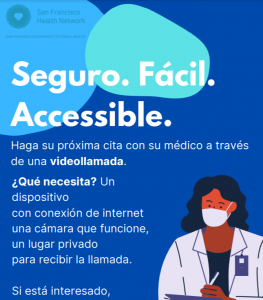Top Takeaways
|
 Whether they were hiring telehealth ambassadors, coordinators, or advocates, safety net health clinics soon realized a key component patients needed for virtual care during the pandemic: A human connection to help bridge the digital divide.
Whether they were hiring telehealth ambassadors, coordinators, or advocates, safety net health clinics soon realized a key component patients needed for virtual care during the pandemic: A human connection to help bridge the digital divide.
But how can clinics offer dedicated support to patients (and providers) without overwhelming their staff? That’s the challenge raised by Jessicca Moore, director of innovation at Petaluma Health Center, on a CCI webinar this year. The answer, according to webinar participants, lies in retraining, repurposing former roles, hiring new employees, getting buy-in from leadershp, and seeking out volunteers to help clinics pivot to virtual visits as part of their COVID-19 response.
These tech advocates work to ensure patients can use online patient portals, so they can sign up for telehealth appointments, request medication refills, message doctors directly, and obtain their lab results online.
These are among the lessons learned by clinics in CCI’s Connected Care Accelerator (CCA). During the swift ramp-up to telehealth required by the pandemic, health clinics in CCA embraced simple, efficient, and cost-effective solutions to help serve their patients remotely. Here’s how four health organizations—Alameda Health System, Salud Para La Gente, San Francisco Health Network, and Petaluma Health Center—used people power to help them continue to deliver quality, compassionate virtual care.
Alameda Health System: Investing in a tech advocate coordinator and volunteers
“FYI: Just used Tech Advocates. They helped a patient set up. The patient was so happy he called back to thank me.”
— Message from clinic employee
Alameda Health System, which consists of five hospitals and four wellness centers, serves an economically marginalized and racially, ethnically, and culturally diverse patient community. As Alameda County’s public health care system, AHS strives to eliminate health disparities and barriers to access in the East Bay Area, which includes Oakland, the largest urban city in the county. Common challenges in the region include a growing wealth disparity gap, affordable housing and homelessness, mental health and substance use disorder challenges, and community and family safety.
Given these urgent needs, AHS hired a tech advocate coordinator to oversee telehealth enrollment. The coordinator is tasked with increasing digital literacy and enrollment rates in the health center’s patient portal, MyAlamedaHealth, a free app for patients to communicate with their healthcare provider. The coordinator supervises the training of volunteer tech advocates, who were brought on during the pandemic to help patients with limited digital literacy. Overseeing this team of volunteers is also a major task.
The clinic hired an internal candidate who had experience both on the tech and patient side of telehealth patient portals. The staffer’s expertise was valuable in creating patient educational flyers and the volunteer manual, dubbed the MyAlamedaHealth Outreach Playbook. He/she? was also a consistent point person for telehealth training and troubleshooting the challenges AHS providers had navigating telehealth platforms—including MyAlamedaHealth, Zoom, and Doximity, an online networking service for medical professionals.
The new role paid off. During the first six months of the project, patient enrollment in MyAlamedaHealth doubled from 7% to 15%. Its success was attributed largely to the work of the tech advocate coordinator. The organization plans to continue the position to drive further portal enrollment and to transition away from email communication with patients to text messaging.
Salud Para La Gente: Troubleshooting with a Specialty Service Coordinator
“Serving as a go-to for trouble-shooting has minimized missed appointments due to technical difficulties.” — Specialty Services Coordinator
At the height of the pandemic, like other health clinics, staff had little bandwidth to support patients who needed tech help to attend video visits. The center decided to trial a position solely dedicated to this task, with the goal of addressing remote visit challenges for patients and staff alike.
Salud then identified an existing staff person, family nurse practitioner Christopher Contini, to serve as a specialty services coordinator to assist patients with video visit support. He called patients one to two days in advance of a telehealth appointment to screen them to see if converting the patient from a phone consult to a video visit was appropriate.
Salud Para La Gente, which serves a large farmworker population, is a federally qualified heath center that serves Santa Cruz and north Monterey counties on California’s Central Coast. The organization provides bilingual, culturally competent care at nine sites—including four school-based clinics. It serves more than 28,000 patients; nearly half of whom are children. Salud’s service area is primarily rural with a predominantly immigrant, Spanish-speaking, farmworker family patient population, many of whom are vulnerable due to low or seasonal wages or their undocumented status. Although the region is known as the nation’s Salad Bowl, Latino farmworkers suffer disproportionately from poor health outcomes due to poverty, inadequate nutrition, obesity, and diabetes.
Given that some patients lack computers and smartphones, Contini screens them to determine whether virtual video visits are appropriate. He also responds to patient messages for technical assistance navigating Zoom and is the go-to person for patients and staff who need tech support for telehealth visits, especially if one is being derailed by tech problems.
With patient education and practice, the coordinator is now finding it easier to flip phone consult appointments to video visits. “It’s been helpful to have this role, especially to support patients, as navigating the video visit may be new or difficult for many,” says Alicia Potes, an adolescent services physician assistant, who says providers have also provided feedback to resolve telehealth problems –such as having patients identify themselves in the waiting room. That alone made a huge difference, she said: “It’s nice to know I am about to see the correct patient.”
The only downside: Without additional support in place, video visits took a nosedive when Contini had to be out of the office for a month. Salud solved that concern by training patient appointment coordinators to cover when the specialty coordinator isn’t available. “The specialty coordinator role has enabled me to seamlessly increase the volume of video consultations I conduct by ensuring that both patient and provider are aware of the appointment the morning of,” says Contini. “Serving as a go-to for trouble-shooting has minimized missed appointments due to technical difficulties.”
San Francisco Health Network: Casting a wide net for telehealth ambassadors
“I like to do video visits because it removes all my transportation issues. It really helped to have someone who could help me to connect for the first time.”
— Patient
Count the staff at San Francisco Health Network as already stretched too thin to prepare patients for a video visit or sign them up for a patient portal. “Patients often need this extra support, and providers don’t have the time,” says one SFHN employee.
SFHN is the public health care delivery system that serves San Francisco’s under-resourced community. It includes Zuckerberg San Francisco General Hospital, the Laguna Honda long-term care facility, and 14 primary care clinics, jail health care, and other community-based programs. The network supports a culturally and linguistically diverse community in an area that has one of the greatest wealth disparities in the country.
Small wonder the need for telehealth ambassadors became glaringly apparent. Where to find folks to do this crucial work? The health network decided to train several second-year medical students to call patients with upcoming telehealth phone visits, screen them for video visit interest and eligibility, and help them download Zoom and prepare for their telehealth visit with their provider. They dubbed these helpers “telehealth ambassadors.” The students spend anywhere from 5 to 30 minutes assisting patients new to the telehealth platform.
In a pilot program, medical students contacted 776 patients. They learned pretty quickly that cold-calling is not an effective means of contact. They also found that 30% of those reached didn’t have a device or internet to perform video visits, and 50% didn’t see the valued added of video compared to a phone visit, though they expressed a willingness to try it if their provider recommended it.
Based on those findings, the health network is continuing the program, drawing on a pool of undergraduates and medical students. In the process, it is figuring out the best place to store information about interest in video visits and other data in the electronic health record, settling on a timeline for how often to screen and and maintain quality assurance.

SFHN advertises its video visits in Spanish as well as Chinese and English (Portion of poster, SFHN)
The health network also needed to determine a referral process to request the help of a telehealth ambassador. The network created a telehealth pool in an in-basket in Epic, the organization’s electronic health record. That way, requests for assistance for a video set-up and patient portal MyChart activation would show up right away. Clinical and administrative staffers also began to incorporate MyChart messages to patients with a Zoom link as part of their routine pre-visit tasks.
Promotion for the video service is ongoing. The network sends patients a simple, consistent message that gives them the opportunity to ask for video visits. “SFHN offers video visits, which allows you to see your doctor without leaving your home. Ask your provider whether a video visit is right for you. Visit this website for info about how to get started: https://sfhealthnetwork.org/videovisits/.”
Petaluma Health Center: Telehealth support specialist made shift to virtual care easier
“I liked the support from staff explaining the process of how I would connect to my future video appointment. It was nice to finally see someone face to face after only having phone visits.”
–PHC patient
What makes a good telehealth support specialist? Being an organized, tech-savvy, passionate and effective communicator who can engage and educate patients about these new tools.
That’s the conclusion of Petaluma Health Center, a federally qualified health organization that serves 35,000 rural and suburban residents annually in Sonoma and Marin counties in Northern California. The center wanted to find a way to improve video connectivity between patients and providers and figure out how much support was needed for remote telehealth appointments, given staffing constraints.
The center settled on the role of telehealth support specialist, who — as the title suggests — supports patients unfamiliar with video visit set-up and supports providers on telehealth visits by assisting with transmitting lab and imaging requests, scheduling follow-up appointments, and communicating with patients.
The center soon learned that keeping things streamlined and simple is best. For example, sending a text message with a video link for instructions on how to do a virtual visit, along with a meeting number proved ineffective. Patients got confused, didn’t watch the video, and thought the link was for their appointment. The center created a simplified text with a direct link to the provider’s waiting room, which worked much better.
The position, which has been implemented at all the center’s clinic sites, has proven popular with patients. “I liked the support from staff explaining how I would connect to my future video appointment,” says Silvia, a patient. “It was nice to finally see someone face to face after only having phone visits.”
|
The COVID-19 pandemic upended the way California delivers health care. Health care systems completely restructured their services to keep both their patients and employees safe. Federal policymakers acted quickly to expand coverage and payment for virtual care. The California Department of Health Care Services also dismantled previous barriers to telehealth and began requiring Medi-Cal managed care plans to pay providers for telephone and video visits at the same rate as in-person visits. As a result, many California health care providers rapidly pivoted from in-person visits to virtual patient visits. For these organizations, this shift has been transformational, as they’ve adopted new technology, overhauled workflows, and redefined team member roles. The Connected Care Accelerator — a partnership between CCI and the California Health Care Foundation, with additional funding from the Blueshield of California Foundation — selected 40 safety net healthcare centers in California to participate in a 12-month program that provided funding, methods, tools and hands-on technical assistance to enhance virtual care initiatives. In a series of case studies, CCI showcases the most sustainable and impactful solutions and shares advice for fellow safety net clinics who want to integrate similar virtual care strategies. |
Find this useful or interesting? We’re constantly sharing stuff like this. Sign up to receive our newsletter to stay in the loop.

